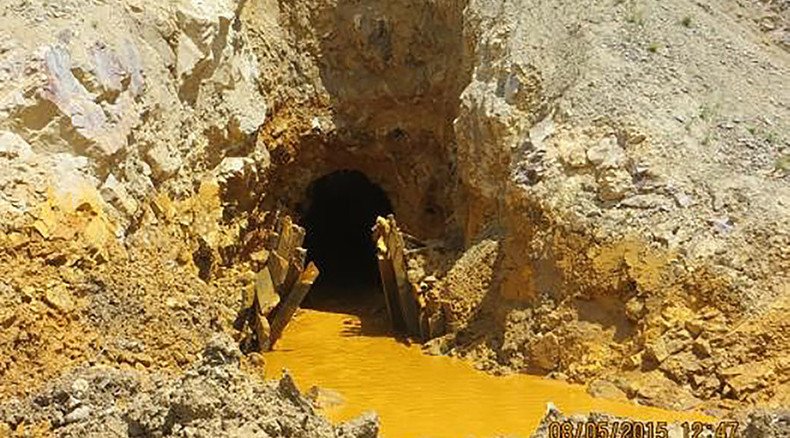Danger of toxic ‘blow-out’ at Colorado mine known to EPA since 2014 – documents

The Environmental Protection Agency knew about the danger of toxic water potentially spilling out of Colorado’s Gold King Mine more than a year ago, new internal documents show. It’s unclear what, if anything, the agency did to reduce the risk.
Released on Friday, the documents show that no maintenance had been conducted at the mine since 1999, and in a document dated June 2014, officials warned that a 1995 mine portal collapse, as well as other subsequent internal collapses, made the mine more susceptible to “blow-out.”
“This condition has likely caused impounding of water behind the collapse,” the document reads. “Conditions may exist that could result in a blow-out of the blockages and cause a release of large volumes of contaminated mine waters and sediment from inside the mine, which contain concentrated heavy metals.”
Three times worse than first reported: #EPA spills 3 million gallons of wastewater into river http://t.co/LOgP16cKSD
https://t.co/jfUjETPoBP
— RT America (@RT_America) August 11, 2015Meanwhile, a document from May 2015 also described the potential for a “blow-out” with the exact same terms. This document was created by a contractor working for the EPA called Environmental Restoration.
Earlier in August, a spill of some 3 million gallons of contaminated mine waste flooded into Cement Creek and eventually made its way into the Animas River, turning the waterway a bright yellow-orange color. The leak was caused when an EPA contractor conducting an investigation tried to excavate the mine’s entrance.
The toxic sludge contains arsenic, cadmium, copper, beryllium, iron, lead, mercury, and zinc. Measurements taken in the spill’s aftermath showed that recorded levels of lead alone were 12,000 times higher than normal. Five water supply systems were hit by the spill, as well as waterways in New Mexico and Utah. In addition to Cement Creek and the Animas River, the San Juan and the Colorado Rivers were also affected.
If you thought the #AnimasRiver spill was an isolated event, think again: http://t.co/AHw29SPIXq via @outsidemagazinepic.twitter.com/pjC8roWPMZ
— Rainforest Alliance (@RnfrstAlliance) August 20, 2015The newly released documents also detail some of the steps outlined by the EPA that environmental workers were to take to reduce the risk of a blow-out at the mine, including rerouting contaminated water to another treatment site and building water management systems. However, there has been no confirmation as to whether these steps had been taken by the time of the spill.
The EPA had also called for the creation of a holding pond where contaminants could be treated, but this had not been finished at the time of the incident.
READ MORE: After Colorado spill, attention turns to threat of old mines
Colorado Attorney General Cynthia Coffman welcomed the release of the documents, but added that more details were needed, specifically regarding what the EPA had done once it had identified the risk of a blow-out.
“When we see the EPA was aware of potential danger ... the next question is with that awareness did they take appropriate caution,” she said, according to the Denver Post.
The EPA has already been blasted for lack of transparency regarding the incident. One of the released documents details the cost estimate for environmental restoration, but all the numbers were redacted. The EPA has spent $3.7 million on cleanup efforts since the spill, the Colorado Springs Gazette reported.
Investigations into the incident are also underway: one being conducted by the EPA’s inspector general and another by the Department of the Interior. Congressional hearings are also slated to begin concerning the environmental calamity in September.
EPA Knew Dangers Of Blowing Up Colorado Gold Mine http://t.co/khBszC4lQvpic.twitter.com/bv68z1evBW
— Colorado Report (@ColoradoReport) August 25, 2015Colorado Governor John Hickenlooper declared a state of disaster emergency following the spill in order to expedite the state’s response. The Navajo Nation also declared an emergency, as its water systems were also severely affected by the waste.
About 600 gallons of waste per minute were still pouring out of the mine as of last week, the Denver Post reported. Sediment ponds have already been dug by the EPA and a water treatment machine is set to be operational at the site by winter.












